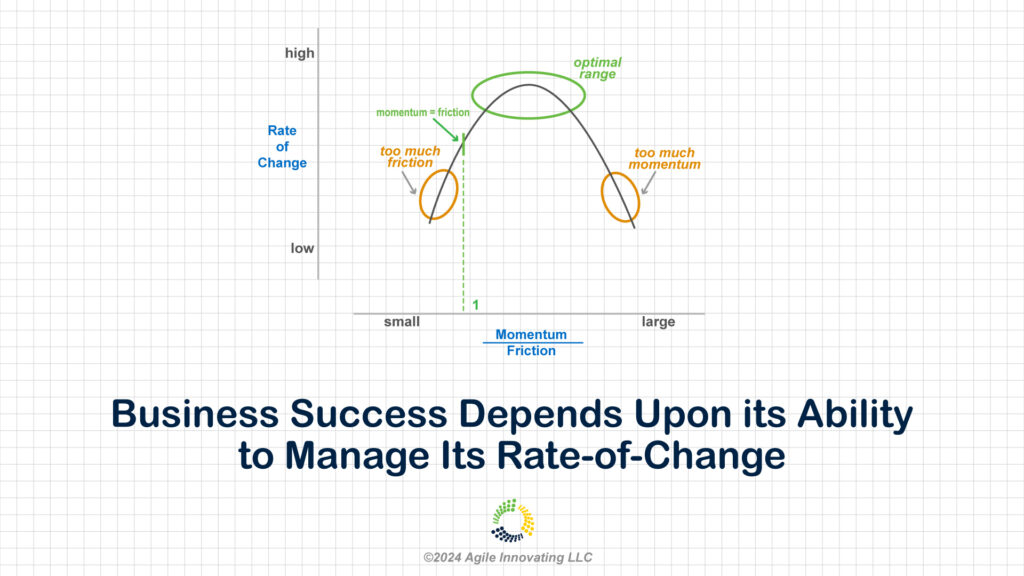
Every business does planning and has plans; Strategic plans, Budgets, Operating Plans, Project Plans. The planning time horizons vary, but the basic premise guiding most plans is that plan execution will be occurring in a stable business environment. In fact, many Strategic Plans, which guide the development of all other plans, are simply linear extrapolations of the current business state into some future state with only nominal change.
This edition of the Agile Innovating ™ Newsletter explores how a business’s basic orientation towards change affects it business prospects. Many businesses treat change in an ad hoc manner, emphasizing stability over change in day-to-day operations.
Rate-of-Change is often an ignored strategic decision that governs business success in both the short and long term. Deciding what a business’s rate-of-change needs to be, and creating and managing that ability, is a key factor in the stability and growth of a business.
Everyone businessman knows that the overall environment will change at some point. But they believe that as long as the business, solution, and market environments are stable, the business can focus on improving the execution of existing plans. Unfortunately as plan execution improves, the business’s ability to adapt and change declines.
The reality is that any specific business, solution, and market environment is rarely stable, undergoing a continuous rate-of-change. If, at some point, the rate-of-change in the business, solution, and market environments starts to exceed the rate-of-change in your business, the long term stability and growth of your business is at risk. The ability to change, at a rate, scope, and scale consistent with your business situation, is a key factor governing the longer term survival of your business.
There are two basic orientations towards change that businesses have.
Reactive Change
One is reactive, responding to and making changes within your business in reaction to changes in the overall business, solution, and market environments. This orientation works as long as long as the overall rate-of-change in the environments is slow enough and your internal rate-of-change is fast enough.
Using this orientation, your business performance will always tend to be lagging behind the overall average performance, but as long as the lag time is short, your business can survive. The advantage of this orientation is that there is little uncertainty concerning the changes you need to make. The risk of this orientation is captured in the difference between the environmental and your business’s rates-of-change. The reactive orientation works best in environments characterized by low rates-of-change.
Proactive Change
The second orientation is proactive, anticipating and causing change in the overall business, solution, and market environments through proactive changes in your business. This orientation works as long as the changes you anticipate and provide become adopted in the environments, creating a new status quo. Using this orientation, your business has the opportunity to significantly out-perform other competitors because your business will be growing into the new status quo while your competitors are trying to change and catch up. The lag time between your business making the changes available and your competitors “catching up” could be a source of considerable competitive advantage.
The advantage of this orientation is that it focuses your organization on business growth. The downside of this orientation is that you must mitigate the uncertainties associated with anticipating what kind of change in the three environments is beneficial, and manage the risk of adoption of the changes you provide. The proactive orientation works best in environments characterized by high rates-of-change.
Conclusion
A reactive orientation to change is a low uncertainty, medium risk, low reward business strategy. Your business must have an effective mechanism to minimize the “time gap” created by the difference between the environmental and your business’s rate-of-change.
A proactive orientation to change is potentially a high uncertainty, high risk, high reward business strategy. Your business must have an effective methodology to mitigate the uncertainties and risk associated with anticipating change in a high rate-of-change environment.
Regardless of your business orientation to change, your business stability and growth depends upon its ability to manage its rate-of-change relative to its environment.
- In combined environments characterized by low rates-of-change, your business rate-of-change must be equal to or only slightly less than the environmental rate-of-change to remain competitive.
- In combined environments characterized by high rates-of-change, your business rate-of-change must exceed the environmental rate-of-change to maintain stability and grow.
- A lower rate-of-change ability in a high rate-of-change environment carries the implication that your business will never “catch up” to the environmental status quo and will ultimately fail.
Business success depends upon creating and managing an appropriate rate-of-change ability.
🌱
Rate-of-Change is key
Reactive or proactive
How fast must you change?
-Innovation Haiku, Kevin A Fee, June 26, 2024
